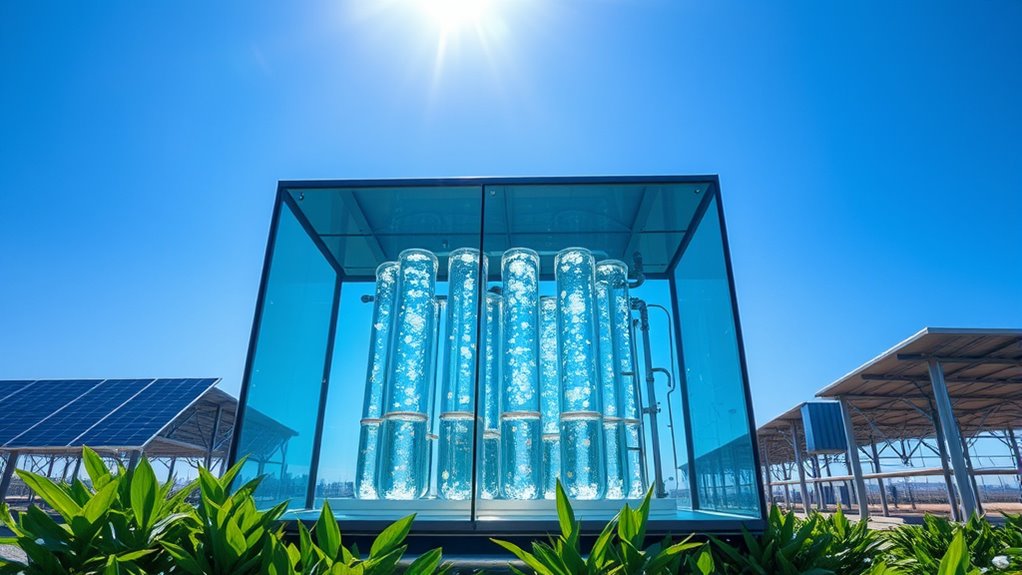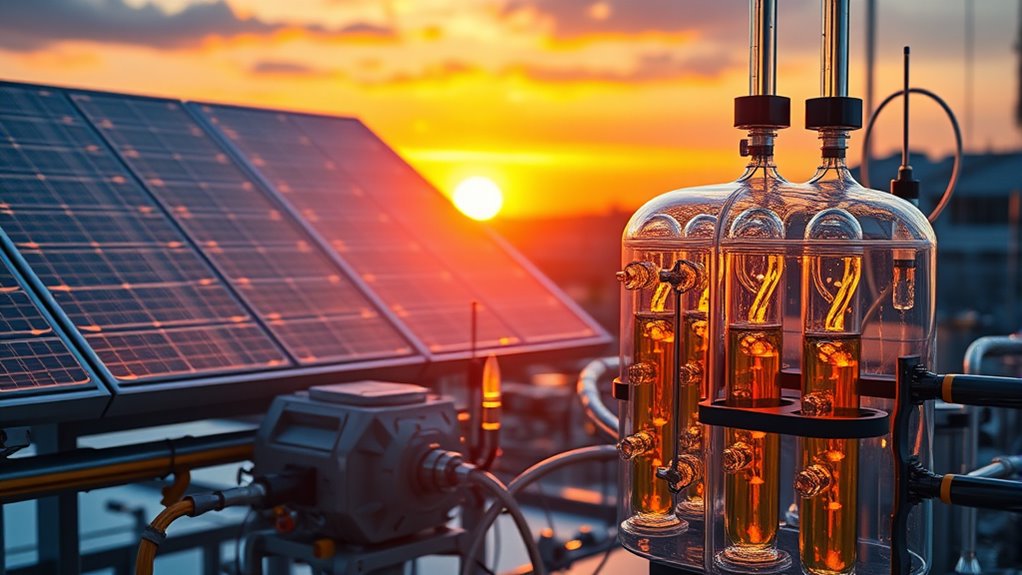Solar fuels are created by capturing sunlight to drive chemical reactions that convert CO₂ into energy-rich fuels like methanol, ethanol, or hydrogen. This process uses advanced solar-powered methods such as water splitting and thermochemical cycles, relying on raw materials like water and CO₂. These fuels offer a cleaner, renewable alternative to fossil fuels with environmental benefits like reduced emissions. Continuing to explore can reveal how these innovative technologies might reshape our energy future.
Key Takeaways
- Solar fuels are produced by harnessing sunlight to convert CO₂ into useful hydrocarbons like methanol or ethanol.
- Photochemical, thermochemical, and electrochemical methods mimic natural photosynthesis using inorganic materials.
- These processes reduce CO₂ emissions, offering a carbon-neutral alternative to fossil fuels.
- Efficient systems require advanced catalysts, high light absorption, and effective energy storage solutions.
- Solar fuels support sustainable energy by providing renewable, scalable options for transportation and industrial applications.
How Solar Fuels Are Made Using Sunlight

Solar fuels are made by harnessing sunlight to power chemical reactions that produce renewable energy sources. You can think of this process as mimicking natural photosynthesis, but with inorganic materials.
In artificial photosynthesis, semiconductor-based photoelectrodes absorb sunlight, generating charge carriers that split water into hydrogen and oxygen. Catalysts then use hydrogen to reduce carbon dioxide, creating fuels like methanol or ethanol. The SUN-to-Liquid project demonstrates a scalable method for producing synthetic fuels directly from sunlight, CO₂, and water. To be effective, these systems need excellent light absorption, efficient charge separation, and active catalytic surfaces. Efficient light absorption is crucial for maximizing energy capture from sunlight, similar to how plants optimize photosynthesis. By replicating how plants use sunlight, you can convert water and CO₂ into useful fuels.
This approach offers a sustainable way to produce energy-rich compounds, reducing reliance on fossil fuels and moving toward a cleaner, renewable energy future.
Various Methods for Producing Solar Fuels

Various methods exist to produce solar fuels, each leveraging different energy conversion processes to harness sunlight efficiently. Thermochemical techniques use high temperatures from solar heat in reactors to split water or convert methane directly into hydrogen, often involving cycles like cerium oxide or copper chloride. These methods store thermal energy to maintain continuous fuel production despite variable sunlight. These high-temperature processes can operate continuously, providing a stable supply of fuels even when sunlight is intermittent. Incorporating advanced thermal storage techniques enhances the efficiency and reliability of these thermochemical systems. Photochemical and artificial photosynthesis mimic natural processes, using sunlight to directly drive chemical reactions that produce hydrogen, methanol, or ethanol. Electrochemical approaches rely on solar-powered electrolysis, splitting water or reducing CO₂ into fuels with photovoltaic-driven cells. Finally, solar redox cycles use metal oxides to store energy thermochemically, generating syngas for further conversion. Each method presents unique advantages and challenges, advancing the diverse landscape of solar fuel technologies.
Raw Materials Needed for Solar Fuel Production

Producing solar fuels requires specific raw materials that serve as the building blocks for chemical reactions powered by sunlight. Water provides hydrogen and oxygen essential for splitting molecules and forming fuels. Carbon dioxide supplies the carbon needed to create hydrocarbons like methanol and ethanol. These elements are abundant and sustainable sources, making them ideal for large-scale production. Solar energy directly heats chemical reactions, enabling the synthesis of various fuels from these raw materials. Nitrogen, from air, is used for nitrogen-based fuels such as ammonia. The raw materials’ availability and purity directly influence the efficiency of fuel synthesis. Additionally, materials like silicon in solar panels capture sunlight, while metals like copper and silver facilitate electrical conduction. Catalysts, including transition metals and chlorophyll-like molecules, enable the chemical conversions. Managing the raw material supply chain for these materials is vital for scaling solar fuel technologies sustainably.
Different Types of Solar Fuels and Their Uses

Different types of solar fuels offer versatile options for harnessing sunlight to generate clean energy. Hydrogen, produced via solar-powered water splitting, fuels fuel cells, industrial processes, and clean transportation. It has high energy density and fits into existing gas infrastructure but needs efficient catalysts to reduce energy input. Compatibility with current infrastructure makes hydrogen an attractive option for seamless adoption. Additionally, advances in headphone technology are improving the user experience with wireless and noise-canceling features. Liquid alcohols like methanol and ethanol, created through solar-driven CO₂ reduction, serve as drop-in replacements for gasoline, diesel, and aviation fuels. They are easily stored and transported in liquid form. Ammonia, made using solar-driven nitrogen fixation, works as a fertilizer, shipping fuel, or hydrogen carrier. It has existing infrastructure and produces no CO₂ emissions upon combustion. Hydrocarbon fuels, generated through solar thermochemical processes, directly replace conventional fuels in engines and aviation. They are compatible with current infrastructure. Each offers unique benefits for clean energy applications.
Advantages of Using Solar Fuels as Energy Sources

Using solar fuels as an energy source offers significant environmental advantages. Since they’re derived from sunlight, a renewable resource, you reduce reliance on finite fossil fuels. Solar fuels help cut carbon emissions by using CO₂ as an input, which can lower greenhouse gases. Solar fuels are considered carbon-neutral because they recycle CO₂ in their production process. They also require minimal water compared to traditional extraction methods, conserving essential resources. Plus, solar fuel production avoids environmental damage like mining and drilling, and it generates energy without pollutants. On the practical side, sunlight is abundant and can power the world’s needs. As technology advances, costs decrease, and efficiency improves, making solar fuels more affordable. They can be stored, transported, and integrated into existing infrastructure, offering reliable, scalable, and eco-friendly energy options for a sustainable future.
Current Challenges in Solar Fuel Technology

Despite its promising potential, solar fuel technology faces significant challenges that hinder widespread adoption. Intermittent weather conditions cause fluctuations in energy production, making consistent fuel synthesis difficult. Diurnal and seasonal variations further impact efficiency, especially at night or during winter. Storage costs remain high, limiting practicality, while low operational temperatures can reduce device lifespan. Technological hurdles include device degradation from environmental exposure, limited efficiency, and scalability issues. Environmental challenges involve weather impacts, land use demands, and resource management. Economically, high initial investments and storage expenses pose barriers, and market fluctuations influence project viability. To illustrate, consider this snapshot:
| Challenge | Impact | Potential Solution |
|---|---|---|
| Intermittency | Unpredictable fuel output | Energy storage innovations |
| Device Degradation | Reduced device lifespan | Better materials |
| Scalability | Difficult to expand cost-effectively | Modular system design |
| Storage Costs | High expenses limit deployment | Cost-efficient batteries |
The Future Potential of Solar Fuel Technologies

Advancements in solar fuel technologies are opening new possibilities for a sustainable energy future. With rapid improvements in perovskite solar cells, you can expect higher efficiencies—over 25% now and surpassing 30% with tandem designs—making solar energy more practical and widespread. These lightweight, flexible cells can be integrated into windows and portable devices, expanding solar’s reach. Green hydrogen, produced via solar-powered electrolysis, is gaining momentum as a zero-carbon fuel for hard-to-electrify sectors like industry and shipping, attracting billions in investments. Solar energy is projected to dominate renewable capacity growth by 2030, with innovative PV technologies playing a pivotal role. Combining solar power with CO₂ reduction creates clean fuels that address intermittency and support decarbonization, paving the way for a sustainable, circular energy ecosystem. solar fuel technologies are also being explored to create synthetic fuels that can seamlessly integrate with existing energy infrastructure.
Environmental Impact and Benefits of Solar Fuels

Solar fuels offer a promising way to cut greenhouse gas emissions and improve air quality by producing energy with minimal environmental impact. During operation, solar-based fuel production emits zero GHGs, helping combat climate change. Additionally, advancements in Kia Tuning technologies can optimize energy efficiency, further reducing environmental footprint. While manufacturing and recycling cause some emissions, these are small compared to fossil fuel extraction and use. Solar fuels recycle CO₂ into useful energy, reducing atmospheric carbon levels. They also eliminate pollutants like sulfur dioxide, nitrogen oxides, and particulates that cause smog and acid rain. Additionally, solar fuel systems generate little to no water pollution and require minimal water, unlike fossil fuel plants. By avoiding air pollutants and water contamination, solar fuels support healthier ecosystems and communities.
How Solar Fuels Could Transform Our Energy System

Solar fuels have the potential to reshape our energy system by providing a sustainable and versatile alternative to conventional fossil fuels. They can diversify energy supplies and leverage existing fuel infrastructure, easing the progression to cleaner energy sources.
Solar fuels can be stored for long periods, offering flexibility in managing supply and demand across sectors like transportation and power generation. Advances in photoelectrochemical cells and photovoltaic electrolysis reactors make production more efficient and cost-effective. Additionally, understanding the Safety of Electric Heated Mattress Pads can guide the development of safer energy storage systems for solar fuels.
These fuels can enhance energy security by reducing dependency on finite resources and imported fuels. They also support grid stability, providing stored energy when sunlight isn’t available.
As research progresses, scaling production and lowering costs will help integrate solar fuels into our economy, transforming how we generate, store, and use energy globally.
Frequently Asked Questions
How Efficient Are Current Solar Fuel Production Methods?
You might wonder how efficient current solar fuel production methods are. Today, most systems achieve around 7% efficiency, but with advanced designs, they can reach up to 40%.
Photoelectrochemical cells and thermal storage improve conversion and storage, boosting overall efficiency. Challenges like device stability and cost remain, but ongoing innovations aim to markedly increase efficiency, making solar fuels more practical and scalable in the near future.
What Are the Main Costs Involved in Solar Fuel Generation?
You need to understand that the main costs in solar fuel generation include high initial investments in photovoltaic panels and specialized equipment.
You also face ongoing operational expenses like maintenance, catalyst replacements, and system monitoring.
You also face costs from energy input inefficiencies, which require larger installations, and financing, affected by regional policies and incentives.
Managing these costs effectively is key to making solar fuel production economically viable.
Can Solar Fuels Be Produced at a Large Scale?
The question of scaling up solar fuels isn’t just about numbers; it’s about transforming our energy future. You can see the potential with plants like Synhelion’s DAWN, which proves large-scale production is possible.
With advancements in technology, thermal storage, and infrastructure, solar fuels can be produced on an industrial scale. This shift promises cleaner, sustainable energy, breaking the mold of fossil fuel dependence for good.
How Do Solar Fuels Compare to Electric Power Storage?
You might wonder how solar fuels compare to electric storage. Solar fuels store energy chemically, offering high energy density and long-term storage, perfect for seasonal needs.
Electric storage, like batteries, provides quick, short-term power and is more cost-effective currently. While batteries are ideal for grid balancing and immediate demands, solar fuels are better suited for heavy-duty sectors and long-duration storage.
This helps you plan for a resilient, sustainable energy system.
Are There Safety Concerns With Handling Solar Fuels?
Like walking a tightrope over a stormy sea, handling solar fuels comes with safety concerns. You need to be cautious of chemical hazards, such as toxicity from metals like lead or cadmium. Proper protective gear and careful management are essential to prevent exposure or spills.
Additionally, fire risks from reactive materials require strict safety protocols. Staying informed, following regulations, and practicing safety measures help you navigate these potential dangers safely.
Conclusion
By harnessing sunlight to turn CO₂ into fuel, you become a steward of the Earth’s future. Solar fuels symbolize hope—a beacon guiding us away from depletion toward sustainable abundance. As you embrace this technology, you participate in a cycle of renewal, transforming sunlight’s fleeting gift into lasting energy. Together, you can ignite a brighter, cleaner world, where each drop of solar fuel reflects your commitment to harmony between humanity and nature’s endless light.









